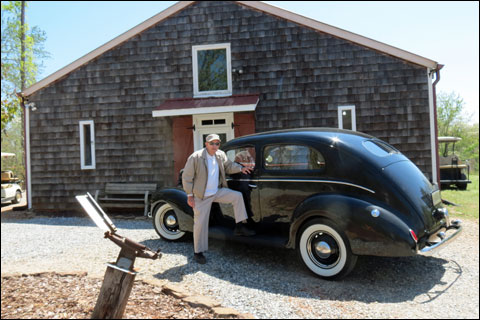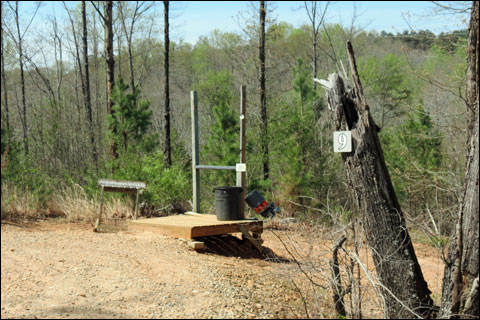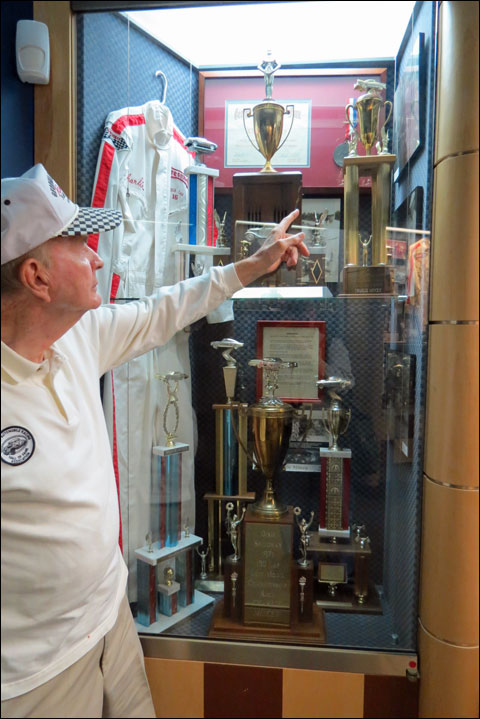[Editor’s note: This article originally appeared at ShotgunLife.com]
In Part I, we met Charlie Mincey, former Georgia moonshine runner who would be our host for evaluating the new Ruger Red Label on sporting clays courses that we visited in a restored 1939 Ford Sedan moonshine car. In Part II, we shot sporting clays with the Ruger Red Label at the Foxhall Resort and Sporting Club as well as Barnsley Gardens — delving deeper into Charlie’s incredible story. Now in our final installment, we stress test the Ruger Red Label at the ravine-intense Etowah Valley Sporting Clays followed by a visit to Dawsonville, which is the heartbeat of the state’s moonshine culture.
Listening to Charlie Mincey’s tales as a moonshine hauler nearly seven decades ago fuels your imagination of secreted copper stills and backwoods scallywags as we navigate Dawson County’s mountains in the 1939 Ford Sedan to shoot the new Ruger Red Label 12-gauge at Etowah Valley Sporting Clays.
Charlie had been chased on kindred roads by Revenue Agents pursuing his own hot-rod 1939 Ford Sedan crammed with gallon cans of corn liquor. Gun shots were fired, cars rolled and overnight hideouts secured in the cat-and-mouse hunts during Charlie’s stint as moonshine wheelman — heroic days to the proud people of Dawsonville.
In Georgia, Dawsonville is moonshine. Every October the town holds its Mountain Moonshine Festival. The weekend fundraiser, which draws more than 100,000 people, celebrates Georgia’s intertwined moonshine and stock-car-racing history. Downtown’s prominent Georgia Racing Hall of Fame shares space with the Dawsonville Moonshine Distillery in a display of solidarity.

Charlie’s son Chuck is manhandling the Ford through hollars and hills. Slack in the big steering wheel demands vigilance. The 100-horsepower flathead V8 requires downshifts of the three-speed to raise revs approaching a hill. Charlie looks back at me from the passenger seat, his voice rising over the drivetrain’s industrial-age cacophony.
“Those were the good old days before the police had radios,” Charlie said of his moonshine shenanigans. “No road blocks ahead.”
He explained that “anytime I got run by the law I never went home that night because they would know where to find me.”
Charlie’s father, who owned a local body shop, would paint Charlie’s car a different color and fill the bullet holes to keep him in the game.
Asked if he carried a gun, Charlie emphatically said no. “If they caught you with a gun, they’d shoot you on the spot and claim self-defense.”
Despite the danger, moonshine’s cash and thrills proved challenging to resist for the teenage Charlie Mincey. As a driver, he earned one-dollar per gallon and on a 200-gallon night profits ran sky high. He splurged on fancy clothes, good times, fast cars and even a trip to New York City where he visited Times Square in the 1950s. “I never saw anything like that,” he reminisced.

In the timeless woods haunted by moonshine legends, our final approach to Etowah Valley Sporting Clays in Dawsonville involved a momentary climb and a dirt road — throwbacks in the 1939 Ford Sedan to Charlie’s bandit chronicles amid a swirl of grey dust from the whitewall tires.
The rustic hilltop clubhouse evoked a moonshine runner’s furtive hideaway. Inside you’re greeted by registration and a pro shop, but deeper back the building resembled a timbered grange hall — the large facility accommodating shooters who also participated in the 5-stand, skeet, trap and guided upland hunts.
We secured a cart, unpacked the 12-gauge Ruger Red Label and gear from the Ford’s trunk and drove into the woods. The two sporting clays courses included 14 stations with the landscape directly influencing difficulty.
The easiest section threw quartering targets across flat stretches of terrain into the trees or across a clearing. Sound-abatement walls like partial cubicles interrupted the land’s natural disposition. Target presentations appeared reasonably standard, although faster than usual.
Having shot about 200 rounds of sporting clays with the Ruger Red Label the previous day at the Foxhall Resort and Sporting Club and Barnsley Gardens, I had readily adjusted to the trigger take-up and auto safety.
Going into the two-day evaluation of the 12 gauge, we had anticipated the muzzle-heavy sluggishness that received so much criticism in the first-generation Ruger Red Label. Yesterday, though, Ruger’s claims of shifting the balance rearward were corroborated across the two sporting clays courses.

Now at Etowah Valley Sporting Clays, with the easier stations behind us, we were driving to sections of the course where trap machines dared us to break long targets traversing the ravines of Georgia moonshine country. It was a realm where clay birds possessed faint resemblance to actual game-bird flight paths in yet another sporting-clays showcase of extreme target setting.
The crevices and hillsides of the mountain forest stretched the Ruger Red Label in swing, balance, accuracy and instinct. Fathoming the Red Label’s true disposition, no lookers were taken here on the rugged terrain: “pull” then shoot.
From stations located on a precipice, plunging targets demanded quick swings and long leads across deceptive backdrops of dappled light and bewildering perspectives. That often meant waiting until the dropping, quartering-out birds became clear and whole amid the dazzle. These last-minute gun mounts were not the Churchill instinctive method of move/mount/shoot but Hail Mary stabs at blowing up Kamikaze clays. The Ruger Red Label shouldered well with surprising results that surpassed our expectations.
A variation on that target involved a trap machine hidden in the woods on either side of the station. Call for the bird, you could hear the mechanical arm and after several seconds an orange blur launched from the vegetation diving toward the bottom of a ravine; and again the Ruger Red Label felt well-behaved often with effective results.
Ultimately, when it comes to shotguns, finesse typically has a price. Nuances in handling are commensurate with cost. A bigger price tag brings you ever closer to that sublime engagement with a shotgun. If someone tells you there’s no difference between shooting a $1,399 shotgun and a $100,000 shotgun they never shot the latter (or they’re in denial).

Leaving Etowah Valley Sporting Clays, our closing impressions of the new Ruger Red Label are generally favorable for a $1,399 over/under. We believe Ruger exorcised many of the demons from its predecessor. Our biggest gripe was trigger creep and again, based on a conversation with the shotgun’s product manager, Craig Cushman, we may have received an aberration. On the other hand, we kept seeing reports on bulletin boards and forums of some first-generation Rugers with similar triggers. Even if the mechanical trigger on our shotgun represented standard production, it rivaled actions in comparably priced semi-autos while surpassing Turkish break-opens that cost the same or less.
The jury is out on durability as new Red Labels ship to dealers. At $1,399, its lasting value will be measured over time, but Ruger’s advanced manufacturing holds promise for superior reliability over past Red Labels.
Load 1-ounce shells with reasonable velocities and you won’t suffer from felt recoil — a chronic complaint about the old Red Label. Bear in mind that over two days we shot more than 300 rounds of sporting clays with zero discomfort. However, based on our experience, we advise against 1⅛-ounce loads, which kicked too hard.
Returning to the old Ford in the parking lot, Charlie said the go-to place for lunch in Dawsonville was the Pool Room restaurant in downtown. The nostalgic burger and barbeque joint, festooned with stock-car memorabilia, was an archeological gem that tracked the automotive evolution from local moonshine hot rods to outlaw stock-car tracks to Daytona 500 fire-breathers.
The pieces on display in the Pool Room presented an automotive history of Charlie’s years behind the wheel. He had stopped running moonshine in 1950 at the urging of his wife, Carolyn. At the time, Charlie was 19, his new bride 16. They’re still married.
“My wife said I could race, but no more moonshine,” he said.

Over sandwiches, Charlie recounted his career racing on so-called outlaw tracks: ¼- and ½-mile ovals packed tight with cars pulled from central casting for Mad Max movies. He recalled moving up from racing early-model Fords to late-model NASCAR-style cars on the short ovals. He eventually switched to a Chevy in late modified racing. The car was sponsored by Day’s Chevrolet, where he worked in the body shop. Charlie’s racing career spanned the 1950s to 1980. In 2004, he was inducted into the Georgia Racing Hall of Fame, where we studied a display dedicated to him.

In the history of Dawsonville, relations run deep when it comes to moonshine and fast cars, as we learned from our distillery tour in the museum lobby.
Dwight “Punch” Bearden is the master distiller of the Dawsonville Moonshine Distillery. He crafts the corn liquor from a traditional Appalachian recipe over 150 years old — handed down to Cheryl “Happy” Wood who owns the operation from her granddaddy, Simmie. Cheryl reputedly comes from nine generations of moonshiners.
Granny Bearden was actually a Mincey related to Charlie’s family before she married a Bearden. Turned out that Charlie drove moonshine for the Beardens.

Dwight is a fourth-generation, Dawson County, backwoods moonshine maker who went legit with the launch of the Dawsonville Moonshine Distillery.
“I started helping daddy when I was six or seven, washing gallon Coke jugs and getting them to the still,” he said. “We made moonshine on an old scrub farm and pumped the water from a spring.”
At age 17, three Federal Agents “beat the hell” out of Dwight, he said, and locked him up in Gainesville, Georgia. They were attempting to extract information about his moonshine-making cousin. A judge in Atlanta ruled that the agents failed to read Dwight his rights. Dwight was released with a mouthful of “bashed-in teeth.”
Some three years ago, Dwight established the museum’s small-batch, copper-pot still — a type he prefers “for low volume and high quality.” By law, Dwight can’t sell Dawsonville Moonshine on the premises. We visited City Liquor, a converted gas station up the street, to purchase a couple of bottles — one “Original Corn Whiskey” and the other “Mountain Apple Pie.” We’ve tasted better Apple Pie moonshine but Dwight’s Original was pretty darn wonderful.
Dinner time approached. We visited Charlie’s modest house, where Carolyn served turkey sandwiches, potato salad and coconut cake for dessert.
Afterwards, Charlie and I moved to the living room, sitting together on the couch. He carried in a few scrap books filled with photos from his glory days of racing. He slowly flipped the pages, narrating as we progressed. For Charlie and the Ruger Red Label, it’s all about redemption.









Join the conversation as a VIP Member